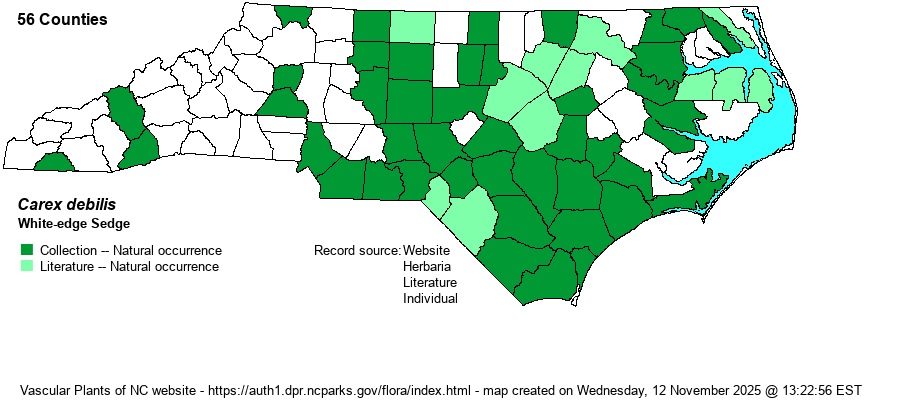| Section 5 » Order Cyperales » Family Cyperaceae |
Show/Hide Synonym
| taxonName | relationship | relatedTaxonName | relatedTaxonRefText | relComments |
|---|
|
|
|
|
| Carex debilis | = | Carex debilis var. debilis | Gleason and Cronquist (1991) | | | Carex debilis | = | Carex debilis var. debilis | Fernald (1950) | | | Carex debilis | = | Carex debilis var. debilis | Flora of North America (1993b, 1997, 2000, 2002a, 2002b, 2003a, 2004b, 2005, 2006a, 2006b, 2006c, 2007a, 2009, 2010) | | | Carex debilis | = | Carex debilis var. debilis | Gleason (1952) | | | Carex debilis | = | Carex debilis var. debilis | Kartesz (1999) | | | Carex debilis | = | Carex debilis var. debilis | | | | Carex debilis | = | Carex debilis var. debilis | Radford, Ahles, and Bell (1968) | | | Carex debilis | < | Carex debilis | Godfrey and Wooten (1979, 1981) | | | Carex debilis | < | Carex debilis | Wofford (1989) | | | Carex debilis | < | Carex debilis | | | | Source: Weakley's Flora |
|
| Author | Michaux | |
| Distribution | Throughout most of the Piedmont and eastward, probably only local in the Mountains. So far verified from these montane counties: Alleghany, Clay, Haywood, and Transylvania. SERNEC specimen records have been accepted here if annotated recently by an expert.
MA to IN south th FL and TX. | |
| Abundance | Frequent to locally common in the Piedmont, Sandhills, and Coastal Plain. Plants are generally common in favorable habitats. Large holes in the northern half of the Coastal Plain should be filled in with more collecting, though seemingly not common in much of this region. Rare in the Mountains and western Piedmont. | |
| Habitat | Moist to mesic soils of floodplain forests, bottomlands, and streamsides. Tolerates limited flooding. |
| Phenology | Flowering and fruiting May-July. | |
| Identification | NOTE: Specimens not mapped here of Carex "debilis" from the upper Piedmont and montane counties need their identifications checked. Many are likely to be C. allegheniensis or C. flexuosa, which are splits from the original C. debilis. Carex debilis in the strict sense is distinguished from the other two by glabrous perigynia (pubescent in C. allegheniensis, glabrous in C. flexuosa) and perigynia 6-10 mm long (vs. 4.5-7 mm long in C. flexuosa). | |
| Taxonomic Comments | Carex debilis in the broad sense has been recently split into three species: nominate C. debilis, C. allegheniensis, and C. flexuosa.
The genus Carex is the largest in North America, and among the largest in the world. In temperate and boreal regions, Carex is often the dominant or co-dominant ground layer in many habitats. Seeds (achenes) are valuable food for birds and small mammals, while foliage is used by birds and mammals to make nests and as food by mammals. Species of Carex often look vastly different from one another -- spikes erect vs. drooping, tiny inflorescence vs. whopping, culms leafy vs. naked, perigynia beaked vs. beakless, stems densely bunched vs. single, etc. The genus has been divided into many sections (or groups), based on shared characters; some taxonomists have suggested that these be different genera, but that proves unworkable (so far). All Carex share the feature of a perigynium (an outer covering) which completely surrounds the achene (seed). This covering may fit tightly or loosely (like a small bladder), depending on which group or species. Details of perigynia shape, ornamentation, presence and size of beak, number of striations (or veins) are all important ID features. In recent years Rob Naczi and colleagues have stressed the importance of arrangement of perigynia -- whether spiral (3+ ranks) or distichous (2-ranked) -- and have named a number of new species as well as split off some older synonyms. Therefore, RAB's (1968) key, excellent for its time, can only be used in a general way today. Members of some sections of Carex are difficult to key out (notably Ovales, Laxiflorae, Griseae); this is in part due to variation among individuals of a species, or failings of the key. FNA has drawings of most species and some species may be found in two or more places within a key, to acount for variability. New species to NC, and new to science(!), continue to be found in NC. | |
| Other Common Name(s) | Weak Sedge | |
| State Rank | S5 | |
| Global Rank | G5 | |
| State Status | | |
| US Status | | |
| USACE-agcp | FACW link |
| USACE-emp | FAC link |

